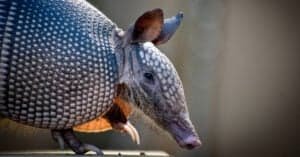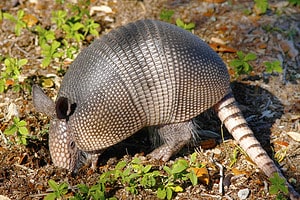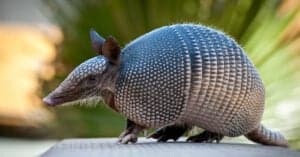Armadillos are mammals that live in burrows and sleep for almost 80% of their day. These animals are in Central, North, and South America, with most species being in South America. Armadillos have impaired vision, but does this make them nocturnal or diurnal? This article explores the sleep behavior of armadillos and discusses whether they are nocturnal or diurnal.
Armadillos are Nocturnal
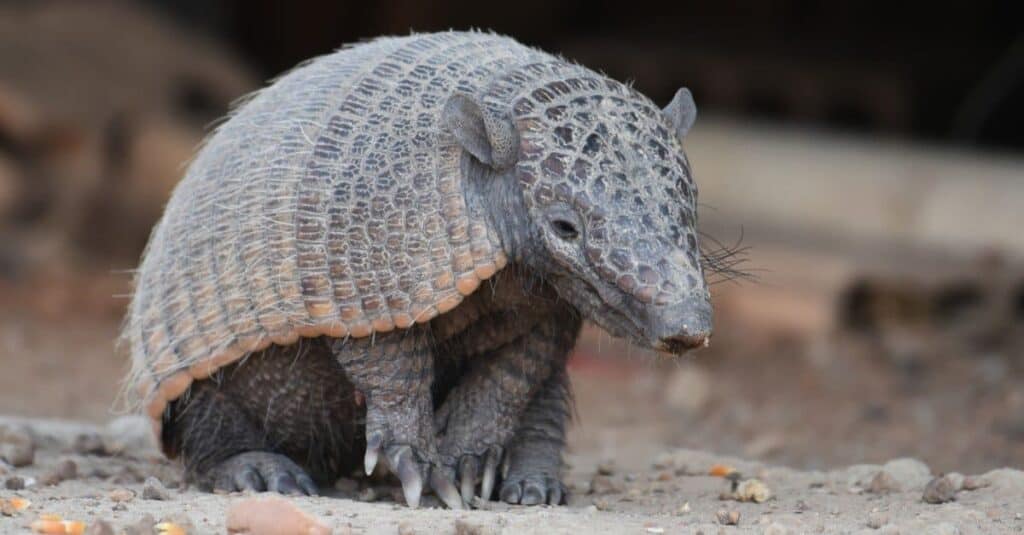
Armadillos are nocturnal but show crepuscular behavior as well.
©iStock.com/Rini Kools
Most armadillos are nocturnal with crepuscular tendencies. As nocturnal animals with crepuscular tendencies, armadillos perform most of their activities at night. But, they appear to be most active just after the sun sets and before it rises. During the day, armadillos usually sleep up to 16 hours in their burrows. These animals rarely share their burrows with other armadillos but do share their space with turtles, snakes, and mice. When armadillos aren’t sleeping, they spend more time foraging than most mammals.
There are 21 different species of armadillo, varying in size. The smallest known species is the pink fairy armadillo, which is about the size of a chipmunk. The largest of this species is the giant armadillo, which can grow as large as a small pig. Most species are nocturnal or show crepuscular behavior, but one is diurnal. The six-banded armadillo is diurnal and forages for food during the day. Six-banded armadillos eat plants, insects, and carrion.
Armadillo Sleep Behavior
Armadillos sleep for almost 80% of their day, which is just under 20 hours. These animals have two sleep states: non-REM sleep and REM sleep. Non-REM rest involves a phase of light slumber just before deep sleep. The body temperature drops, the eyes stop moving, and the heart rate and muscles continue to relax. Brain activity briefly rises and then slows down. REM sleep begins an hour later, with the first period usually lasting ten minutes and each period lasting longer and longer. Brain activity increases, but the body enters a state of temporary paralysis. Armadillos exhibit most of the classical elements of REM sleep. Some of these elements include EEG activation, hippocampal theta, muscle relaxation, irregular breathing, rapid eye movements, and limb and whisker twitching.
Where do Armadillos Sleep?

Armadillos sleep for almost 20 hours each day.
©iStock.com/Saddako
Among all armadillo species, the nine-banded armadillo is the most common and inhabits parts of Central, North, and South America. Most armadillos live in warm regions of North America due to their lack of fat reserves. Armadillos typically have an average body temperature of 91 to 97 degrees Fahrenheit, much lower than expected for placental mammals. They are picky about their habitat, usually choosing loose, sandy soils to burrow in at night. This choice of sand makes it easier for them to make shelters and dig for food.
Nine-banded armadillos like to excavate in warm, moist soil near streams and streams. These animals use their powerful claws to create multiple underground shelters around their range. Armadillos use these dwellings to protect themselves from extreme weather and predators. However, they are not territorial and may roam further afield to find better habitats. An armadillo’s burrow is about seven to eight inches wide and 15 feet deep. Other burrowing animals like skunks, rats, and snakes may take over the abandoned dwellings of armadillos
Armadillos have Poor Eyesight
Armadillos have lousy eyesight, which is strange because they are nocturnal animals. Their eyes lack light-sensitive cells called cones, resulting in blurry, colorless vision. Additionally, their light-sensitive eye cells called rods are so sensitive that sunlight effectively blinds these nocturnal animals. But their poor eyesight can help people.
To study diseases that cause blindness in humans, scientists will typically genetically “knock out” cone-related genes in animals such as mice. Such studies are limited because scientists can only test one gene at a time when many different genes contribute to cone dysfunction. By comparing armadillo genes to other closely related mammals, scientists have identified several cone-related genes in the armadillo genome that stopped functioning millions of years ago. These mammals could be the key to gene therapy experiments, restoring color vision and pointing the way to potential human treatments.
Good Hearing and Sense of Smell

Armadillos have an excellent sense of smell and good hearing.
©iStock.com/6381380
Armadillos have an excellent hearing sense and a keen sense of smell. These senses help nocturnal armadillos with nighttime navigation. They have an olfactory bulb in their brains that senses smell and takes up about 1/3 of the cerebrum. The brain’s cerebrum is responsible for learning and memory. Armadillos can sniff out insects six inches below the surface of the earth. They also use this strong smell sense to locate potential threats and predators.
Armadillos use their hearing to locate any potential food and prey around them. Some species have large protruding or cylindrical ears. Various armadillos species have more prominent ears than others, but all have good hearing. Large ears help them hear low frequencies, like the subtle movements of insects in the soil. An armadillo’s ears move from side to side, allowing it to pinpoint prey, whether a scurrying insect or a lizard.
Certain armadillo species are more adept at picking up low frequencies than others. This ability is essential for those that dig a lot, as low frequencies travel better in underground environments than high frequencies. When armadillos hear low frequencies, they interpret this sound as a warning that predators are approaching their burrows. Screaming hairy armadillos have the most voluminous middle ears. This species’ enlarged middle ear cavity is adapted to low-frequency hearing in arid rather than subterranean environments.
Only One Species of Armadillo Hibernates
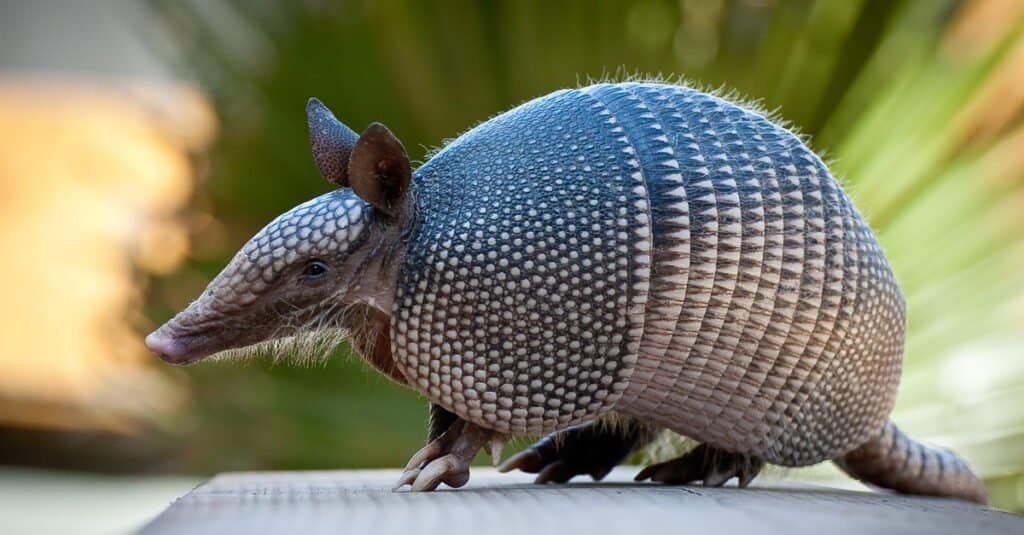
Most armadillos do not hibernate.
©Heiko Kiera/Shutterstock.com
Armadillos do not hibernate but are less active in cold weather. Armadillos can hide in their burrows for some time during the winter. However, they cannot gain body fat or store food, so at some point, they will have to leave their burrow to forage. They usually do this during the day when the temperatures are warm, which shows diurnal behavior due to environmental factors. This behavior puts them at risk of freezing to death, but they risk starvation if they remain in their burrows.
Pichis are the only known species of armadillo that hibernates. Like many wintering animals, it stores a significant amount of fat before entering its burrow from May to August. During hibernation, these true hibernators’ body temperature drops from about 95 degrees Fahrenheit to 57 degrees Fahrenheit.
Nocturnal vs. Diurnal: What’s The Difference?
Navigate to Nocturnal vs. Diurnal: What’s The Difference? for further information about the nocturnal and diurnal phenomenon in various living creatures.
Up Next
The photo featured at the top of this post is © iStock.com/Saddako
Sources
- National Library of Medicine, Available here: https://www.ncbi.nlm.nih.gov/pmc/articles/PMC5357719/
- National Library of Medicine, Available here: https://www.ncbi.nlm.nih.gov/pmc/articles/PMC7163662/
- National Library of Medicine, Available here: https://www.ncbi.nlm.nih.gov/pmc/articles/PMC6986372/
- Science Direct, Available here: https://www.sciencedirect.com/science/article/abs/pii/0031938473903107
- Research Gate, Available here: https://www.researchgate.net/publication/5925033_Hibernation_and_daily_torpor_in_an_armadillo_the_pichi_Zaedyus_pichiy
- Digital Commons, Available here: https://digitalcommons.unl.edu/cgi/viewcontent.cgi?article=1006&context=vpc9
Thank you for reading! Have some feedback for us? Contact the AZ Animals editorial team.



